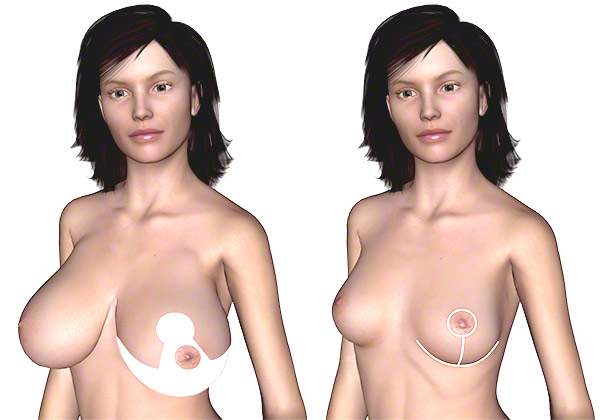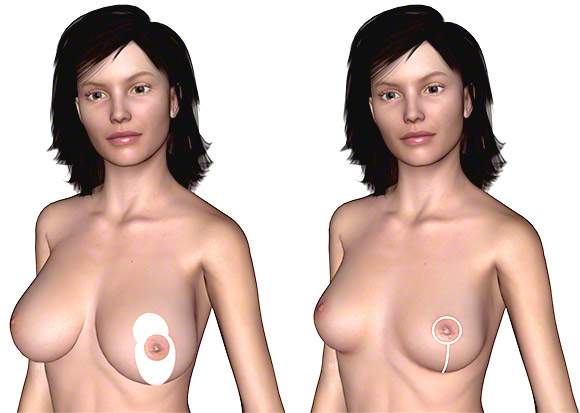At the Yuveo Clinic Düsseldorf, we are happy to fulfill your wish for a breast reduction (breast reduction, mammary reduction, mammoplasty) thanks to a wide variety of surgical techniques and our many years of experience in this field.
We will be happy to explain the breast reduction options and our procedure to you below.
Contents
Yuveo Clinic
Special features of breast reduction
We offer breast reductions for both women and men. We adapt our approach accordingly. Special incision techniques ensure an optimal result.
Breast reduction for women
Breast reduction for men
Liposuction
Nipple complex
Methods and procedure of breast reduction
During breast reduction, we remove mammary gland tissue, fatty tissue and skin. We cut around the areola and thus reduce its size. We also move the areola upwards. It is not possible to operate without scars! Our Düsseldorf team of plastic surgeons can only try to leave as few and inconspicuous scars as possible.
We would like to briefly explain our breast reduction procedure to you below. On the one hand, this is about the incision and, on the other, about the surgical procedure.
- The T-cut is also called the anchor cut.
- The i-breast reduction does not require a transverse scar in the underbust fold.
- Breast reduction with incision around the entire areola (breast reduction is only possible to a small extent)
- In many cases, breast reduction can be performed with an internal fixation (= internal bra).
How does the operation work?
Smoking should be stopped for 2 weeks before breast reduction surgery to minimize the risk of wound healing disorders.
The procedure must be performed under general anesthesia and takes about 2.5 – 4 hours.
The incision depends on the amount of tissue to be reduced.
Depending on the extent of the breast reduction, an inpatient stay of at least one night should be taken into account.

Frequently asked questions about breast reduction
What are the reasons for breast reduction?
We use breast reduction to correct breasts that are too large (macromastia), which is a breast deformity .
Many women suffer from overly large breasts. They often feel that other people stare at them because they are too big.
This often leads to an unconsciously curved posture of the thoracic spine in order to hide the breasts.
In addition, patients who wish to have their breasts reduced usually report a number of symptoms that are the result of the excess weight of the breasts. Patients often complain of back and neck pain. In this respect, around 80% of women feel relief immediately after breast reduction.
The weight causes bra constrictions on the shoulders. Inflamed skin areas (macerations) and fungal infections are more common in the underbust crease, especially in summer.
The poor posture caused by the weight can lead to signs of wear and tear in the thoracic and cervical spine. Sporting activities are hardly possible.
Finding the right size is a challenge.
Conservative therapy is useless for large breasts, as physical measures and psychotherapy do not eliminate the actual problem, the high weight of the breast.
This can only be achieved by breast reduction. Our plastic surgery specialists in Düsseldorf can also reduce the weight of a patient with pre-existing cervical spine syndrome or thoracic spine pain syndrome by reducing the size of the breast, thereby alleviating the symptoms and delaying further deterioration.
If the patient is generally overweight, an attempt should be made to lose weight before undergoing breast reduction surgery, as in some patients the weight loss can be more noticeable than average on the breasts. This means that breast reduction is sometimes unnecessary after weight loss. However, in many cases a breast lift is then desired due to the resulting excess skin.
Overly large breasts in men are called gynecomastia. In this case, breast reduction is usually corrected by liposuction and/or a small incision.
Only in extreme cases is a reduction necessary, as in the case of women.
What incisions are available for breast reduction?
The procedures for breast reduction differ only slightly from one another. The main basic techniques can be described as T-incision, I-incision and L-incision and can be applied in a similar way to breast lifting.
Figure 1: 1: The area of skin that is removed during the T-incision is highlighted. 2. the resulting scar course.
The T-cut is also known as the anchor cut:
Breast reduction with a T-incision is certainly the most frequently used incision technique in breast plastic surgery. The scar at the end runs around the areola, then vertically into the crease under the breast and across this crease, like an upside-down “T”.
With this technique, a considerable amount of skin can be removed both horizontally and vertically. This means that even with large and/or sagging breasts, a good end result without sagging and wrinkles can be expected.
The final result is visible relatively quickly, as there is no need to rely on long-lasting scarring and skin shrinkage as with breast reduction with an i-incision.
However, the technique is associated with long scarring. It should therefore not be used on women who are prone to severe bulging scarring (= hypertrophic scar, keloid = benign tumor), if possible.
Figure 2: 1: The skin area that is removed during the i-incision technique of breast reduction is highlighted.
2. the resulting scar course of the i-incision.
The i-cut is a low-scar procedure:
The so-called i-incision is a low-scar procedure. The scar goes around the areola and then vertically into the crease under the breast. No incision is made across this fold.
As a result, the distance from the nipple to the underbust fold and the excess skin here is too large.
The surgeon in our team therefore detaches the skin in this area from the fatty tissue so that it can shrink better. In addition, we place the vertical suture as a gathering suture to reduce the distance between the nipple and the underbust fold. This creates small skin folds that should shrink over time as the skin shr inks.
The surgeon now relies on the skin’s tendency to shrink. This is certainly good at a young age. This also works fantastically well for a smaller breast reduction or breast lift.
However, if the skin quality is no longer optimal, skin shrinkage will not take place to the desired extent. This also applies to a larger reduction. In such cases, the wrinkles in the area of the vertical scar are permanently visible. The distance between the nipple and the fold under the breast increases again and the breast sags.
Follow-up operations are then inevitable and can lead to beautiful results if a scar in the lower breast crease is accepted. It is usually necessary to wait 6 to 12 months postoperatively before deciding whether such a follow-up operation is necessary. After that, the findings will not change significantly.
The likelihood of corrective surgery can be reduced. If the horizontal excess skin is larger than expected, we can minimize it by widening the incision in the underbust fold. The result is then a “small T-incision”.
What is the L-cut?
The L incision is quite similar to the I incision. In order to reduce the remaining excess skin in the horizontal direction described above, the incision is extended outwards in an “L” shape. However, we use the “small T incision” more frequently, as we can better correct the excess skin in the middle.
What is particularly important for the nipple complex?
The nipple complexes are somewhat affected during breast reduction and breast lift surgery. They are reduced in size and moved upwards.
If the upward displacement is not too great, we do this via a “skin stalk”, which ensures blood flow to the areola. If this is too long, kinked or squeezed too much, the blood circulation can deteriorate considerably.
The areola becomes pale (lack of blood inflow) or blue (lack of blood outflow).
If the blood circulation cannot be improved, it is usually only possible for part of the nipple complex to die off. This means a prolonged healing process, which depends on the amount of dead tissue.
Today, however, this is extremely rare, even with a major breast reduction.
In extreme cases, when the nipple needs to be raised by more than 10 cm, a possible transplantation of the nipple complex will also be mentioned during the consultation in Düsseldorf.
This means that the areola is completely separated and then sewn into its new bed. Fixation with pressure for the first 5-7 days is vital so that the tissue can grow in. We can only see whether it has succeeded after approx. 1-2 weeks.
Nowadays, transplants of nipple complexes only have to be performed in exceptional cases during breast reduction.
What is the follow-up treatment after breast reduction at our Düsseldorf clinic?
- Drains:
At the end of the breast reduction in Düsseldorf, we insert two suction drains, which we remove after 1-5 days. - Compression:
In the first 24 hours after breast reduction it is particularly important to remain calm so that a small vessel that has been sclerosed does not burst open again. You can also minimize the risk by wearing a compression bandage for one night. - Showering:
If a waterproof dressing is used, our patients can shower carefully shortly after the drains have been removed. The dressing must remain dry beforehand. - Stitches: We remove stitches that do not dissolve on their own after 10-14 days.
- Bra:
Our plastic surgeons recommend that you wear your bra for 4-6 weeks after the procedure. - New development of mammary gland tissue:
The very rare new development of mammary gland tissue after breast reduction occurs mainly in young women or is hormonally induced as a result of pregnancy. - Sport:
After a breast reduction, you should generally refrain from sport for 6 weeks. This applies in particular to sports that are likely to involve significant movement of the shoulder girdle and rib cage. Other sporting activities can be practiced 1-2 weeks earlier. - Sleeping on your stomach:
Sleeping on your stomach is only permitted from the 7th week after a breast reduction. In the first few weeks, sleeping on your stomach can cause stitches to open due to the increased tension. Later on, the fresh scars can still be overstretched, which can result in wider scars after complete healing.
What are the expected costs?
The costs of a breast reduction are variable. They depend on the following factors:
- Scope of the operation
- Length of hospital stay
- Anesthesia costs
- Fee of the plastic surgeon
A normal breast reduction involves the costs of the actual operation. There is also the anesthetic fee. In some clinics, there are also costs for the hospital stay. For a medium or large breast reduction, you should plan to stay in hospital for one to a few days.
In the case of extreme dimensions (gigantomastia), the costs for breast reduction can also be higher due to the increased effort involved.
For more details and exact costs, please ask your plastic surgeon. Our Düsseldorf team will be happy to assist you.
When is the cost of breast reduction surgery covered by health insurance?
The costs for a breast reduction are relatively high, as the operation can take 2.5 to even 4 or 5 hours, depending on the extent of the findings, and is associated with an inpatient stay.
It is therefore not surprising that patients suffering from macromastia (abnormally large breasts) demand that their health insurance fund cover the costs of this condition.
In the context of cost savings in the healthcare system, cost coverage for medium-sized breasts has become a rarity.
However, breast reduction for very large breasts is still covered by health insurance – but when?
In order to speak of a breast malformation or disease, there must be a clear disproportion between the body stature and the breast size.
This can lead to mental illness even without common complaints, as many women feel discriminated against and harassed by the looks of some men.
If you are undergoing psychological treatment for these reasons and because of the resulting depression, this is an illness in the sense of the health insurance, so that the costs should be covered.
The costs of breast reduction surgery will usually be covered by health insurance if, in addition to the factors described above, there are clear symptoms of macromastia. These include
- Bra constrictions at the shoulders
- Static complaints in the cervical and thoracic spine treated by an orthopaedic surgeon.
- Maceration (damaged, inflamed skin) and possibly fungal infections in the underbust fold are treated by the dermatologist.
As a general rule, health insurance covers the costs of illnesses and malformations, but not cosmetic procedures! The diagnosis of macromastia (abnormally large breasts) is one of the malformations of the female breast.
The decision as to when to speak of macromastia is at the discretion of the experts from the health insurance fund’s medical service.
Facts
- Practitioners: Dr. Schumann and Dr. Schumann-Averkiou
Treatment duration:
about 2.5 to 5.0 hours- Anesthesia:
General anesthesia - Hospital stay:
Inpatient stay - Aftercare:
Compression underwear, wear a bra, rest for one week - Sociability:
after about 7 days - Sport:
Light sport without involving the chest and shoulder area after approx. 4 weeks, intensive sport after 6 weeks - Costs: on request
Further information on breast reduction






